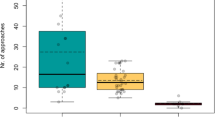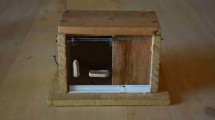Abstract
Animals’ reactions to novel objects vary not only with zoological taxa and their ecology but also in the types of presented stimuli, the context, and individual characteristics. Behavioral reactions can vary from extremely neophobic (avoiding novel objects) to extremely neophilic (intense exploration of novel objects); most often, a mixture of these behavioral patterns appears. In primates, reactions toward novel objects vary according to species, age, sex, population, and the types of objects. Most experiments in this field have used a free exploration design with food or non-food objects. Here, we tested the reactions of captive male rhesus macaques using various stimuli, motivation levels, rewards, and time limits. We found that the monkeys explored and manipulated novel objects in various contexts, with little evidence of a neophobic response; however, environment, types of stimuli, and other parameters of the test can significantly affect monkeys’ reactions.


Similar content being viewed by others
References
Addessi E, Chiarotti F, Visalberghi E, Anzenberger G (2007) Response to novel food and the role of social influences in common marmosets (Callithrix jacchus) and Goeldi’s monkeys (Callimico goeldii). Am J Primatol 69:1210–1222
Barnett SA (1958) Experiments on neophobia in wild and laboratory rats. Br J Psychol 49:195–201
Byrne G, Suomi SJ (1996) Individual differences in object manipulation in a colony of tufted capuchins. J Hum Evol 31:259–267
Carter AJ, Marshall HH, Heinsohn R, Cowlishaw G (2012) How not to measure boldness: novel object and antipredator responses are not the same in wild baboons. Anim Behav 84:603–609
Chamove AS (1983) Role or dominance in macaque response to novel objects. Motiv Emot 7:213–228
Day RL, Coe RL, Kendal JR, Laland KN (2003) Neophilia, innovation and social learning: a study of intergeneric differences in callitrichid monkeys. Anim Behav 65:559–571
Drea CM (1998) Social context affects how rhesus monkeys explore their environment. Am J Primatol 44:205–214
Exnerova A, Jezova D, Stys P et al (2015) Different reactions to aposematic prey in 2 geographically distant populations of great tits. Behav Ecol 26:1361–1370
Fedigan LM, Asquith PJ (1991) The monkeys of Arashiyama: thirty-five years of research in Japan and the West. SUNY Press, New York
Forss SIF, Schuppli C, Haiden D et al (2015) Contrasting responses to novelty by wild and captive orangutans. Am J Primatol 77:1109–1121
Fu W, Zhao D, Qi X et al (2013) Free-ranging Sichuan snub-nosed monkeys Rhinopithecus roxellana: Neophobia, neophilia, or both? Curr Zool 59:311–316
Glaser D, Tinti J-M, Nofre C (1996) Gustatory responses of non-human primates to dipeptide derivatives or analogues, sweet in man. Food Chem 56:313–321
Greenberg R, Mettke-Hofmann C (2001) Ecological aspects of neophobia and neophilia in birds. In: Jr VN, Thompson CF (eds) Current ornithology. Springer, New York, pp 119–178
Gustafsson E, Krief S, Saint Jalme M (2011) Neophobia and learning mechanisms: how captive orangutans discover medicinal plants. Folia Primatol 82:45–55
Gustafsson E, Jalme MS, Bomsel M-C, Krief S (2014) Food neophobia and social learning opportunities in great apes. Int J Primatol 35:1037–1071
Hardus ME, Lameira AR, Wich SA et al (2015) Effect of repeated exposures and sociality on novel food acceptance and consumption by orangutans. Primates 56:21–27
Hikami K, Hasegawa Y, Matsuzawa T (1990) Social transmission of food preferences in Japanese monkeys (Macaca fuscata) after mere exposure or aversion training. J Comp Psychol 104:233–237
Itani J (1958) On the acquisition and propagation of a new food habit in the natural group of the Japanese monkey at Takasaki-Yama. Primates 1:84–98
Johnson E (2000a) Food-neophobia in semi-free ranging rhesus macaques: effects of food limitation and food source. Am J Primatol 50:25–35
Johnson E (2000b) Food neophobia in rhesus macaques (Macaca mulatta). University of Georgia (unpublished doctoral dissertation)
Johnson EC (2007) Rhesus macaques (Macaca mulatta) are not neophobic toward novel food with a high sugar content. Am J Primatol 69:591–596
Jones RB (1986) Responses of domestic chicks to novel food as a function of sex, strain and previous experience. Behav Process 12:261–271
Kawai M (1960) A field experiment on the process of group formation in the Japanese monkey (Macaca fuscata), and the releasing of the group at Ôhirayama. Primates 2:181–255
Kendal RL, Coe RL, Laland KN (2005) Age differences in neophilia, exploration, and innovation in family groups of callitrichid monkeys. Am J Primatol 66:167–188
Kinnally EL, Whiteman HJ, Mason WA et al (2008) Dimensions of response to novelty are associated with social engagement and aggression in adult male rhesus macaques (Macaca mulatta). J Comp Psychol 122:195–203
Laska M (2001) A comparison of food preferences and nutrient composition in captive squirrel monkeys, Saimiri sciureus, and pigtail macaques, Macaca nemestrina. Physiol Behav 73:111–120
Lester D (1967) Sex differences in exploration: toward a theory of exploration. Psychol Rec 17:55
Meddock TD, Osborn DR (1968) Neophobia in wild and laboratory mice. Psychon Sci 12:223–223
Menzel EW (1966) Responsiveness to objects in free-ranging Japanese monkeys. Behaviour 26:130–150
Mettke-Hofmann C, Winkler H, Leisler B (2002) The significance of ecological factors for exploration and neophobia in parrots. Ethology 108:249–272
Nedvidek J, Nekovarova T, Bures J (2008) Spatial choices of macaque monkeys based on the visual representation of the response space: rotation of the stimuli. Behav Brain Res 193:204–208
Nekovarova T, Nedvidek J, Bures J (2006) Spatial choices of macaque monkeys based on abstract visual stimuli. Behav Brain Res 174:93–100
Nekovarova T, Nedvidek J, Klement D, Bures J (2009) Spatial decisions and cognitive strategies of monkeys and humans based on abstract spatial stimuli in rotation test. Proc Natl Acad Sci USA 106:15478–15482
Nekovarova T, Nedvidek J, Klement D et al (2013) Mental transformations of spatial stimuli in humans and in monkeys: rotation vs. translocation. Behav Brain Res 240:182–191
Russell PA (1973) Relationships between exploratory behaviour and fear: a review. Br J Psychol 64:417–433
Sabbatini G, Stammati M, Tavares MCH, Visalberghi E (2007) Response toward novel stimuli in a group of tufted capuchins (Cebus libidinosus) in Brasília National Park, Brazil. Am J Primatol 69:457–470
Santos LR, Hauser MD, Spelke ES (2001) Recognition and categorization of biologically significant objects by rhesus monkeys (Macaca mulatta): the domain of food. Cognition 82:127–155
Visalberghi E (1988) Responsiveness to objects in two social groups of tufted capuchin monkeys (Cebus apella). Am J Primatol 15:349–360
Visalberghi E, Fragaszy D (1995) The behaviour of capuchin monkeys, Cebus apella, with novel food: the role of social context. Anim Behav 49:1089–1095
Visalberghi E, Myowa Yamakoshi M, Hirata S, Matsuzawa T (2002) Responses to novel foods in captive chimpanzees. Zoo Biol 21:539–548
Visalberghi E, Sabbatini G, Stammati M, Addessi E (2003) Preferences towards novel foods in Cebus apella: the role of nutrients and social influences. Physiol Behav 80:341–349
Weiskrantz L, Cowey A (1963) The aetiology of food reward in monkeys. Anim Behav 11:225–234
Acknowledgements
We are grateful to Eva Landova for valuable comments and discussion of the experiments. This study was performed in full accordance with the ethical guidelines of Charles University in Prague. All of the procedures complied with the Animal Protection Code of the Czech Republic and with European Council directives (2010/63/EC; 86/609/EEC). The study protocol was approved by the Animal Care Committee of the 3rd Faculty of Medicine at Charles University, Prague, Czech Republic. This article does not contain any studies with human participants. Our research was funded from grants 260388/SVV/2018 and Progres Q 35 by Charles University. This study is a result of the research funded by the project Nr. LO1611 with financial support from the MEYS under the NPU I program. The study was also supported by GA UK project no. 1508414 by Charles University. We have no conflicts of interest to disclose.
Contract Grant sponsor: Charles University, Contract Grant number: GAUK 1508414, Contract Grant number: 260388/SVV/2018, Contract Grant number: Progres Q 35; Contract Grant sponsor: Ministry of Education, Youth and Sports, Contract Grant number: NPU I (LO1611).
Author information
Authors and Affiliations
Corresponding authors
Additional information
Publisher's Note
Springer Nature remains neutral with regard to jurisdictional claims in published maps and institutional affiliations.
Electronic supplementary material
Below is the link to the electronic supplementary material.
About this article
Cite this article
Englerova, K., Klement, D., Frynta, D. et al. Reactions to novel objects in monkeys: what does it mean to be neophobic?. Primates 60, 347–353 (2019). https://doi.org/10.1007/s10329-019-00731-2
Received:
Accepted:
Published:
Issue Date:
DOI: https://doi.org/10.1007/s10329-019-00731-2




